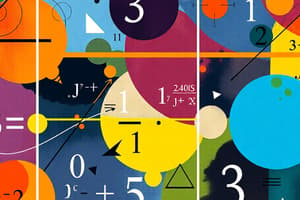Podcast
Questions and Answers
What is the purpose of the division operation in mathematics?
What is the purpose of the division operation in mathematics?
- To split a number into equal parts. (correct)
- To calculate the difference between two numbers.
- To determine the larger number in a comparison.
- To find the total of a number group.
Which logical operator is used to combine two statements such that both must be true?
Which logical operator is used to combine two statements such that both must be true?
- AND (∧) (correct)
- NOT (¬)
- OR (∨)
- IF (→)
What does the universal quantifier (∀) signify in logical statements?
What does the universal quantifier (∀) signify in logical statements?
- Only some instances are relevant.
- There exists at least one instance.
- At least one statement is false.
- All instances are considered. (correct)
In problem-solving strategies, what step follows 'devising a plan'?
In problem-solving strategies, what step follows 'devising a plan'?
Which of the following is an application of mathematics specifically in medicine?
Which of the following is an application of mathematics specifically in medicine?
What is the focus of algebra in mathematics?
What is the focus of algebra in mathematics?
Which theorem states that in a right triangle, the sum of the squares of the two shorter sides equals the square of the longest side?
Which theorem states that in a right triangle, the sum of the squares of the two shorter sides equals the square of the longest side?
What operation does the symbol ∫ represent in mathematics?
What operation does the symbol ∫ represent in mathematics?
Which branch of mathematics includes the study of data including concepts like mean and variance?
Which branch of mathematics includes the study of data including concepts like mean and variance?
What is the primary purpose of calculus in mathematics?
What is the primary purpose of calculus in mathematics?
What does the Fundamental Theorem of Algebra assert?
What does the Fundamental Theorem of Algebra assert?
What type of mathematics is focused on discrete structures, including graph theory?
What type of mathematics is focused on discrete structures, including graph theory?
Which option describes the concept of the Central Limit Theorem?
Which option describes the concept of the Central Limit Theorem?
Flashcards are hidden until you start studying
Study Notes
Key Concepts in Mathematics
1. Branches of Mathematics
- Arithmetic: Basic operations (addition, subtraction, multiplication, division).
- Algebra: Study of mathematical symbols and rules for manipulating them. Includes solving equations and working with variables.
- Geometry: Study of shapes, sizes, and properties of space. Includes points, lines, angles, surfaces, and solids.
- Trigonometry: Study of relationships between angles and sides of triangles. Key functions: sine, cosine, tangent.
- Calculus: Study of change and motion. Involves differentiation (finding rates of change) and integration (finding areas under curves).
- Statistics: Study of data collection, analysis, interpretation, and presentation. Includes concepts like mean, median, mode, variance, and probability.
- Discrete Mathematics: Study of mathematical structures that are fundamentally discrete rather than continuous. Includes graph theory and combinatorics.
2. Fundamental Theorems
- Pythagorean Theorem: In a right triangle, ( a^2 + b^2 = c^2 ) (where ( c ) is the hypotenuse).
- Fundamental Theorem of Algebra: Every non-constant polynomial equation has at least one complex root.
- Central Limit Theorem: The distribution of sample means approaches a normal distribution as the sample size increases, regardless of the original distribution.
3. Important Mathematical Symbols
- x, y, z: Variables, often used to represent unknown quantities.
- =: Equals, indicating equality between two expressions.
- +/-: Plus/Minus, indicating a value can be either positive or negative.
- ∑: Summation, representing the sum of a sequence of numbers.
- ∫: Integral, representing the area under a curve.
4. Common Mathematical Operations
- Addition (+): Combining two or more numbers to get a sum.
- Subtraction (−): Taking one number away from another to get a difference.
- Multiplication (×): Repeated addition of a number.
- Division (÷): Splitting a number into equal parts.
5. Mathematical Logic
- Statements: Propositions that are either true or false.
- Logical Operators:
- AND (∧)
- OR (∨)
- NOT (¬)
- Quantifiers:
- Universal (∀): For all.
- Existential (∃): There exists.
6. Problem-Solving Strategies
- Understand the Problem: Read carefully and identify what is being asked.
- Devise a Plan: Consider possible strategies (e.g., drawing a diagram, creating an equation).
- Carry Out the Plan: Execute the chosen strategy step-by-step.
- Review/Reflect: Check the solution and the process used to find it.
7. Applications of Mathematics
- Finance: Interest calculations, budgeting, investment analysis.
- Engineering: Problem-solving in design, construction, and technology.
- Medicine: Statistics in clinical trials, medical imaging techniques.
- Computer Science: Algorithms, data structures, and cryptography.
Branches of Mathematics
- Arithmetic: Focuses on basic operations including addition, subtraction, multiplication, and division.
- Algebra: Involves mathematical symbols and rules to solve equations and work with variables.
- Geometry: Examines shapes, sizes, and spatial properties, encompassing points, lines, angles, surfaces, and solids.
- Trigonometry: Analyzes relationships between the angles and sides of triangles, featuring key functions like sine, cosine, and tangent.
- Calculus: Studies change and motion through differentiation (rates of change) and integration (areas under curves).
- Statistics: Concerns data collection, analysis, interpretation, and presentation, highlighting concepts such as mean, median, mode, variance, and probability.
- Discrete Mathematics: Investigates discrete mathematical structures, including graph theory and combinatorics.
Fundamental Theorems
- Pythagorean Theorem: In right triangles, relates sides with the equation ( a^2 + b^2 = c^2 ) where ( c ) represents the hypotenuse.
- Fundamental Theorem of Algebra: States that every non-constant polynomial equation has at least one complex root.
- Central Limit Theorem: As sample size grows, the distribution of sample means approaches a normal distribution regardless of the original distribution.
Important Mathematical Symbols
- Variables (x, y, z): Commonly used to represent unknown quantities.
- Equals Sign (=): Indicates equality between two expressions.
- Plus/Minus (±): Represents that a value may be either positive or negative.
- Summation Symbol (∑): Represents the sum of a sequence of numbers.
- Integral Symbol (∫): Denotes the area under a curve.
Common Mathematical Operations
- Addition (+): Combines two or more numbers to yield a sum.
- Subtraction (−): Deducts one number from another to derive a difference.
- Multiplication (×): Acts as repeated addition of a number.
- Division (÷): Divides a number into equal sections.
Mathematical Logic
- Statements: Affirmations that are either true or false.
- Logical Operators:
- AND (∧)
- OR (∨)
- NOT (¬)
- Quantifiers:
- Universal (∀): Indicates "for all".
- Existential (∃): Indicates "there exists".
Problem-Solving Strategies
- Understand the Problem: Analyze the question carefully to determine what is asked.
- Devise a Plan: Assess potential strategies like diagramming or equation formulation.
- Carry Out the Plan: Implement the chosen strategy methodically.
- Review/Reflect: Validate the solution and assess the problem-solving process used.
Applications of Mathematics
- Finance: Utilized for interest calculations, budgeting, and investment assessments.
- Engineering: Essential for problem-solving in design, construction, and technology fields.
- Medicine: Applies statistics in clinical trials and various medical imaging techniques.
- Computer Science: Involves algorithms, data structures, and cryptography for enhanced efficiency and security.
Studying That Suits You
Use AI to generate personalized quizzes and flashcards to suit your learning preferences.




